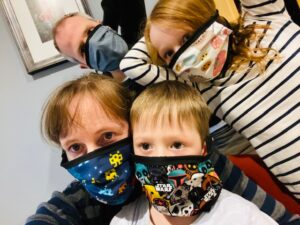 As a culture – we’ve always viewed masks as mysterious. From the Phantom of the Opera to Zorro, masks have been used to create distance in characters and to inspire fear or awe. Perhaps this is why so many of us are struggling with the idea of wearing a mask for most of our interaction these days. From midnight on Wed 22 July, due to the spread of COVID-19 it will be mandatory to wear masks out in public for the forseeable future. And that is going to be strange for everyone.
As a culture – we’ve always viewed masks as mysterious. From the Phantom of the Opera to Zorro, masks have been used to create distance in characters and to inspire fear or awe. Perhaps this is why so many of us are struggling with the idea of wearing a mask for most of our interaction these days. From midnight on Wed 22 July, due to the spread of COVID-19 it will be mandatory to wear masks out in public for the forseeable future. And that is going to be strange for everyone.
In our team, our Speech Pathologists are working online with families currently – so no masks are needed. But it’s got us thinking about the way wearing a mask can change things and potentially make communication so much harder. We’ve reviewed a few articles and also come up with our own ideas about communication, mask wearing and suggestions to improve it!
Most people rely on verbal language to communicate, even though nonverbal communication is just as important as the words we use. Across cultures, and facial expressions are the same, for happiness, sadness, anger, and fear. Our faces can express emotions without saying a word. Once we are each wearing a mask, the nonverbal communication we all take for granted will become increasingly difficult, and we may not even realise why communication seems so much harder.
Nonverbal communication is the way we connect with our fellow humans. While we’re social distancing and wearing masks, it’s more important than ever that we all take responsibility and make the best possible use of our own nonverbal communication.
Who is most affected by mask-based communication challenges?
People with hearing loss – many people with even mild hearing loss rely on some element of lip reading. If a person is profoundly deaf, they may not realise a person wearing a mask is speaking at all.
Parents and teachers – it is much harder to show interest in what a child is doing or saying in a mask, and often it’s your excited or happy faces that help to keep an interaction going. It’s also often your slight frown that your child reacts to when you want them to stop. You no longer have this tool! Speech which is muffled by a mask can be less engaging (and harder to hear) and for kids to pay attention to during play. The old trick of getting down to your child’s eye level so they see your face is a LOT less effective when wearing a mask.
People with cognitive impairments –non-verbal communication is really important to support people with dementia, who can often interpret facial expressions far better than words. People with other types of cognitive impairment may understand someone’s meaning by their tone and volume, body language or facial expressions.
People with autism spectrum disorders – may have been taught to rely on facial expressions to interpret the meaning of what is said to them. Without these social cues, communication can be much harder to understand.
Young children – will often rely on the facial expressions of their caregivers to interpret unfamiliar situations. The adult can reassure them quickly with a smile and the child understands they can then carry on. This is much harder in a mask with just a quick glance and you may find young children seeking more verbal or physical reassurances.
Is there anything I can do?
Be mindful! Think about how you typically communicate when you don’t have a mask on – and then consider what else you could do instead to offer the same meaning. For example, if you always greet strangers on the street with a smile, you may now need to say “hi” for the same meaning.
Speak loudly and clearly as your speech can be muffled in the mask and can be much harder to hear (or even work out who is speaking)
Exaggerate your intonation to show your emotion as you can’t use facial expressions to enhance your message
Use gestures to support what you mean e.g., hold out your arms, beckon, lean your body toward the child, thumbs up or down

Try to convey your message with your eyes as much as possible such as using wide eyes when surprised, disapproving eyes / frown when you’re attempting to discourage a behavior, smiling eyes when happy, sad eyes when upset – this can take some practice in the mirror as what may feel exaggerated to you, may not look that different (or how you thought it would).
If you’re hanging out with kids – explain how they can now understand your feelings, even with the mask on e.g., “My eyes look happy – see – they’re all crinkly at the sides!” or letting them know when you’re smiling even if they can’t see it. If you can see your child seeking reassurance from you, consider a gesture like a thumbs up when you would have previously offered a smile.
For parents – take time to play with your masks so that children become more comfortable with seeing masks in their community. Take them on and off to show that the person wearing them is still the same – even if part of their face is hidden (you might even like to consider wearing a badge with your picture on it if your little one really wants to see you). For young children, playing with a mask can turn into a game of peekaboo with different facial expressions when the mask come off where parents reveal a smile, frown, surprised look, or guessing games where children have to tell by your eyes what feeling you’ll show when the mask comes off.
Know that communication will feel a bit different for a while. Take your time, be kind, and remember it’s strange and new for everyone.
If all else fails, we recommend getting a cape to wear with your mask. It will be a nice talking point, and seemed to work well for most of our masked heroes – Batman, Phantom, Zorro, even Darth Vader rocked a good mask / cape combo.
Reference articles
Burke, L., (2020) Improving Communication for Seniors While Wearing a Mask
Livshits, H., & Greenberg, J., (2020) COVID-19: How Educators Can Build Interactions While Balancing Precautions
Schogol, M., & Jones, C.A., (2020) Maintaining Our Humanity Through the Mask: Mindful Communication During COVID ‐19


